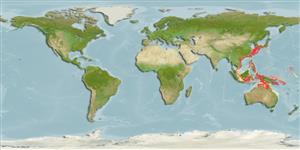Environment: milieu / climate zone / rango de profundidad / distribution range
Ecología
marino asociado a arrecife. Subtropical
Western Pacific: southern Japan, Taiwan and the Philippines.
Tamaño / Peso / Age
Madurez: Lm ? range ? - ? cm
Max length : 20.0 cm SL macho / no sexado; (Ref. 559)
Espinas dorsales (total) : 10; Radios blandos dorsales (total) : 14; Espinas anales: 3; Radios blandos anales: 7.
Body shape (shape guide): fusiform / normal.
Inhabits deeper rocky reefs (Ref. 39231).
Life cycle and mating behavior
Madurez | Reproducción | Puesta | Huevos | Fecundidad | Larva
Heemstra, P.C. and J.E. Randall, 1999. Serranidae. p. 2442-2547. In K.E. Carpenter and V.H. Niem (eds.) FAO species identification guide for fishery purposes. The living marine resources of the Western Central Pacific. Vol. 4. Bony fishes part 2 (Mugilidae to Carangidae). Rome, FAO. 2069-2790 p. (Ref. 39231)
IUCN Red List Status (Ref. 130435: Version 2025-1)
Threat to humans
Harmless
Human uses
Herramientas
Special reports
Download XML
Fuentes de Internet
Estimates based on models
Preferred temperature (Referencia
123201): 15.3 - 27.7, mean 23.2 °C (based on 361 cells).
Phylogenetic diversity index (Referencia
82804): PD
50 = 0.5000 [Uniqueness, from 0.5 = low to 2.0 = high].
Bayesian length-weight: a=0.01349 (0.00618 - 0.02945), b=3.00 (2.81 - 3.19), in cm total length, based on LWR estimates for this (Sub)family-body shape (Ref.
93245).
Nivel trófico (Referencia
69278): 3.4 ±0.45 se; based on food items.
Resiliencia (Referencia
120179): Medio, población duplicada en un tiempo mínimo de 1.4-4.4 años (Preliminary K or Fecundity.).
Fishing Vulnerability (Ref.
59153): Low vulnerability (14 of 100).
🛈
